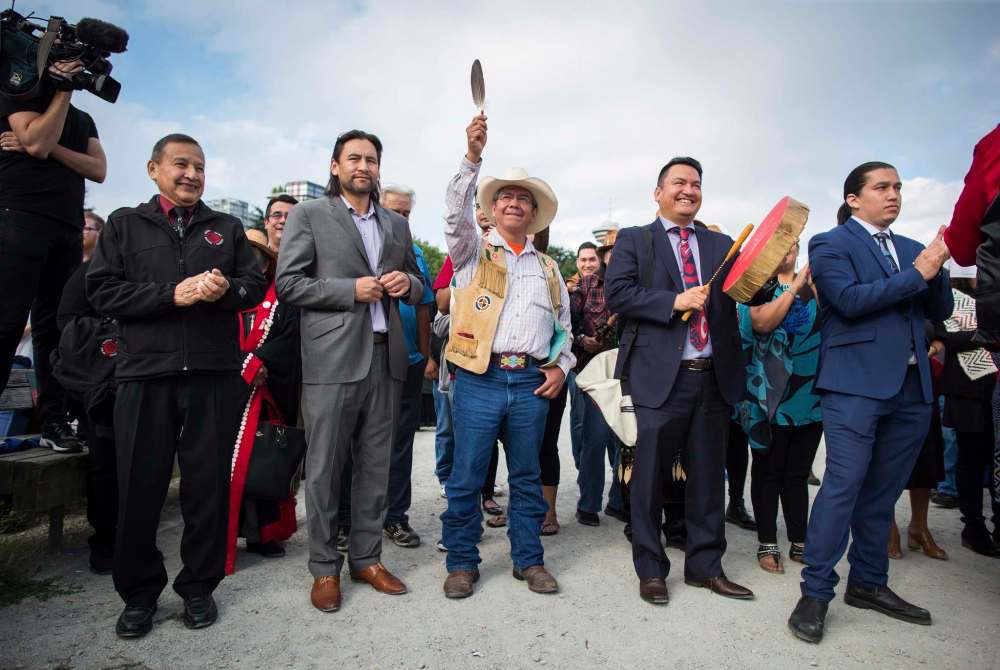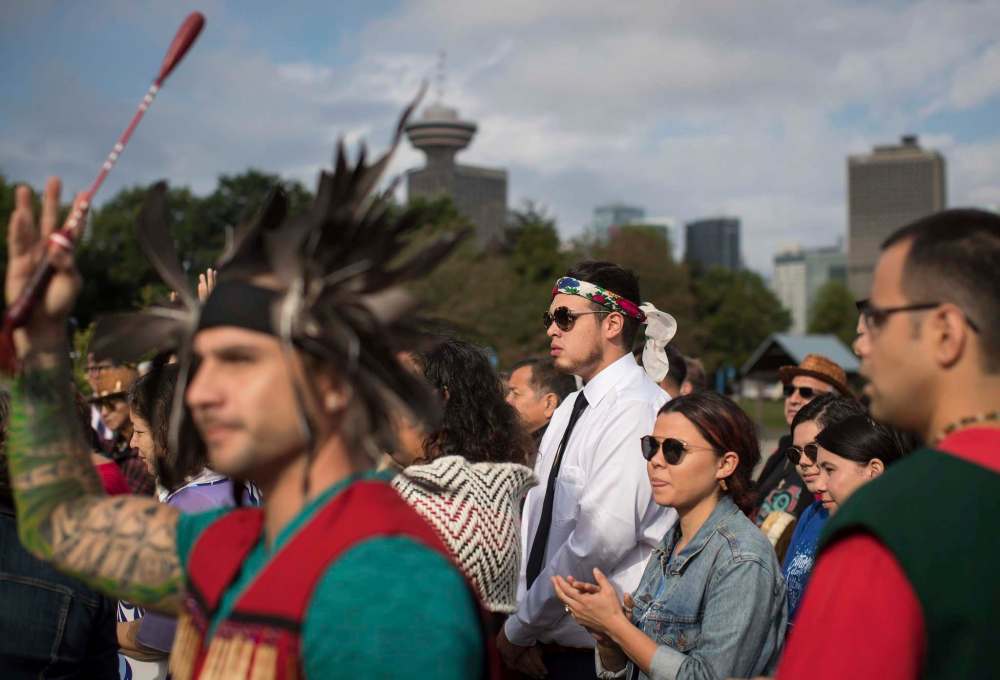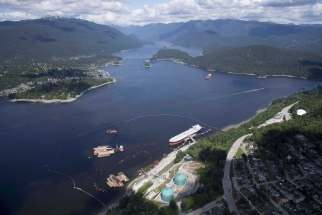Pipeline decision may open door to true consultation with Indigenous peoples
Read this article for free:
or
Already have an account? Log in here »
To continue reading, please subscribe:
Monthly Digital Subscription
$0 for the first 4 weeks*
- Enjoy unlimited reading on winnipegfreepress.com
- Read the E-Edition, our digital replica newspaper
- Access News Break, our award-winning app
- Play interactive puzzles
*No charge for 4 weeks then price increases to the regular rate of $19.00 plus GST every four weeks. Offer available to new and qualified returning subscribers only. Cancel any time.
Monthly Digital Subscription
$4.75/week*
- Enjoy unlimited reading on winnipegfreepress.com
- Read the E-Edition, our digital replica newspaper
- Access News Break, our award-winning app
- Play interactive puzzles
*Billed as $19 plus GST every four weeks. Cancel any time.
To continue reading, please subscribe:
Add Free Press access to your Brandon Sun subscription for only an additional
$1 for the first 4 weeks*
*Your next subscription payment will increase by $1.00 and you will be charged $16.99 plus GST for four weeks. After four weeks, your payment will increase to $23.99 plus GST every four weeks.
Read unlimited articles for free today:
or
Already have an account? Log in here »
Hey there, time traveller!
This article was published 31/08/2018 (2659 days ago), so information in it may no longer be current.
This isn’t the end of the Trans Mountain pipeline expansion project, but it might be the end of a cycle.
On Thursday, the Federal Court of Appeal rejected the National Energy Board’s approval of the project, stating the NEB failed to consult adequately with First Nations communities. In other words: until this happens, the twinning of the pipeline that carries oil to the West Coast from Alberta cannot be legally built.
This was not the only reason for the decision (the court also found the NEB failed to adequately consider the project’s impacts on marine life), but represented a remarkable development in Indigenous relations.
Let’s examine how Canada has historically done business when it comes to lands and resources claimed by Indigenous communities.
Following the Seven Years’ War, when the British defeated the French, King George III claimed dominion over North America in 1763, by making a Royal Proclamation.
This did two things: 1) it defined lands west of British coastal colonies as “Indian Territories” and pronounced the Crown as the primary liaison with Indians, and 2) created a process in which Indians could “freely” sell their lands (basically on terms set by and at a price declared by the Crown) and thus be moved to lands “reserved” for them.
With the stroke of a pen, Indigenous peoples became little more then pawns and land-sellers in a grand acquisition plan.

This is the legal foundation for Canada, the basis for Canadian land claims and, eventually, treaty-making. Sir John A. Macdonald’s western expansion, the reserve system, and the Indian Act all emerge from the Royal Proclamation of 1763.
At its core is the premise the Crown controls the lands and lives of Indians and – besides “freely” agreeing to this – they have no say otherwise. (How anyone can “freely” agree to give up freedom is a legal puzzle but, hey, welcome to Indigenous life.)While Canada recognizes Aboriginal “title,” the parameters of this title is often framed in a way Canada understands land– as something to be owned, extracted from, and exploited. This is what drives Canadian partnerships with corporations and announcements of mines, pipelines and dams in “the national interest.”
With the Royal Proclamation in place, Canada proceeded like a bully who barged into a neighbour’s home, threw $5 down, imprisoned the neighbours, declared they “freely” chose this, and started remodelling.
When Indigenous peoples resisted – and did in many ways – laws were created to tighten the grip. Movement was outlawed. Lawyers were banned. Prisons were filled.
Until the 1950s and ’60s, Canada never really had to worry about Indigenous resistance or land claims or consultation because the Crown set the rules. Then, things began to change.
Decades of non-Indigenous allies, civil rights leaders, and Indigenous activists bravely fought, organized, and attained law degrees to carve out a small piece in Canada’s 1982 Constitution, entitled Section 35.
Section 35 recognizes and affirms “Aboriginal and treaty rights.” This means anything and everything in Canada must consider these rights and cannot override them.
The problem? The Constitution never defines Section 35, and, for almost three decades, the Canadian government has refused to do so, leaving it mostly to the courts.

While Canada recognizes Aboriginal “title,” the parameters of this title is often framed in a way Canada understands land – as something to be owned, extracted from, and exploited. This is what drives Canadian partnerships with corporations and announcements of mines, pipelines and dams in “the national interest.”
Timeline: Key dates in the history of the Trans Mountain pipeline
Here are some key dates in the history of the Trans Mountain pipeline and Kinder Morgan Canada’s efforts to expand its capacity.
Here are some key dates in the history of the Trans Mountain pipeline and Kinder Morgan Canada’s efforts to expand its capacity:
October 1953: The Trans Mountain pipeline begins shipping oil with an initial capacity of 150,000 barrels per day. The project features four pump stations along its 1,150-kilometre route and a marine dock that connects loading facilities on the east side of Edmonton with ocean tankers in Burnaby, B.C.
1957: Pipeline capacity is expanded via the construction of a 160-kilometre pipeline loop. The Westridge Marine Terminal is built and commissioned in Burnaby, B.C.
Jan. 14, 1985: Trans Mountain’s biggest spill occurs at a tank farm in the Edmonton area. Nearly 10,000 barrels of oil are released.
2006 – 2008: The Anchor Loop project adds 160 kilometres of new pipeline through Jasper National Park and Mount Robson Provincial Park between Hinton, Alta., and Hargreaves, B.C. The extension includes 13 new pump stations and modifications to existing stations, increasing capacity from 260,000 bpd to 300,000 bpd.
Feb. 21, 2012: Kinder Morgan says it wants to expand the Trans Mountain pipeline after receiving support from oil shippers and will begin public consultations.
Dec. 16, 2013: An application is made to the National Energy Board (NEB) to expand the Trans Mountain pipeline. Construction is proposed to begin in 2017, with the aim of having oil flow through the expansion by December 2019.
November 2014: More than 100 people are arrested after they camp out in a conservation area on Burnaby Mountain, east of Vancouver, to block crews from conducting drilling and survey work related to the pipeline expansion. Most of the charges are later dropped.
August 2015: The NEB postpones public hearings after striking from the record economic evidence prepared by a Kinder Morgan consultant who was to begin working for the regulator.
Jan. 12, 2016: Alberta Premier Rachel Notley says in a written submission to the NEB that the Trans Mountain pipeline expansion is in the best interests of both Alberta and Canada.
Jan. 27, 2016: The federal Liberal government says pipeline projects such as the Trans Mountain expansion will now be assessed in part on the greenhouse gas emissions produced in the extraction and processing of the oil they carry. Proponents will also be required to improve consultations with First Nations.
May 17, 2016: Ottawa appoints a three-member panel to conduct an environmental review of the Trans Mountain expansion project.
May 29, 2016: The NEB recommends approval of the pipeline, subject to 157 conditions, concluding that it is in the public interest.
Nov. 29, 2016: Prime Minister Justin Trudeau sanctions the Trans Mountain expansion, part of a sweeping announcement that also saw approval of Enbridge’s Line 3 pipeline replacement but the end of its Northern Gateway project.
Jan. 11, 2017: B.C. Premier Christy Clark announces her support for the project, saying Kinder Morgan has met five government conditions including a revenue-sharing agreement worth up to $1 billion.
May 15, 2017: The Federal Court of Appeal grants Notley’s government intervener status in a lawsuit filed by municipalities and First Nations against the project.
May 25, 2017: Kinder Morgan makes its final investment decision to proceed with the development, now estimated to cost $7.4 billion, subject to the successful public offering of Kinder Morgan Canada.
May 29, 2017: The B.C. NDP and Greens agree to form a coalition to topple the Liberal party, which won a minority government in an election earlier in the month. The parties agree to “immediately employ every tool available” to stop the project.
May 30, 2017: Kinder Morgan Canada debuts on the Toronto Stock Exchange after a $1.75-billion public offering.
June 29, 2017: The B.C. Liberals lose a no-confidence vote, clearing the way for NDP Leader John Horgan to become premier.
Aug. 10, 2017: The B.C. NDP government hires former judge Thomas Berger to provide legal advice as it seeks intervener status in the legal challenges against the project filed by municipalities and First Nations.
Oct. 26, 2017: Kinder Morgan Canada asks NEB to allow work to begin despite a failure to obtain municipal permits from the City of Burnaby
Dec. 7, 2017: NEB allows Kinder Morgan Canada to bypass Burnaby bylaws.
Jan. 17, 2018: Kinder Morgan Canada warns the Trans Mountain expansion project could be a year behind schedule.
Jan. 18, 2018: NEB establishes a process to resolve permitting issues between Kinder Morgan Canada and provincial and municipal authorities.
Jan. 30, 2018: B.C. government moves to restrict any increase in diluted bitumen shipments until it conducts more spill response studies, a move that increases the uncertainty for Trans Mountain.
March 9, 2018: B.C. Supreme Court grants interim injunction aimed at preventing anti-pipeline activists from protesting construction at two terminals in Burnaby.
March 15, 2018: B.C. Supreme Court grants indefinite injunction preventing protesters from coming within five metres of two work sites for the project.
March 23, 2018: Green Party Leader Elizabeth May and New Democrat MP Kennedy Stewart arrested at a protest against the pipeline expansion; Federal Court of Appeal dismisses a B.C. government bid challenging a NEB ruling that allows Kinder Morgan Canada to bypass local bylaws.
March 27, 2018: City of Burnaby, B.C., says it will file an appeal to the Supreme Court in connection with the Federal Court of Appeal ruling.
April 8, 2018: Kinder Morgan Canada suspends non-essential spending on the Trans Mountain expansion project and sets a May 31 deadline to reach agreements with stakeholders.
May 29, 2018: Federal government announces deal to buy the Trans Mountain pipeline and expansion project from Kinder Morgan Canada for $4.5 billion.
Aug. 23, 2018: The Supreme Court dismisses an appeal by the City of Burnaby to reconsider a lower court decision that denied the port city leave to appeal the ruling by the National Energy Board.
Aug. 30, 2018: The Federal Court of Appeal overturns the Trudeau government’s approval of the contentious Trans Mountain pipeline expansion. In a unanimous decision by a panel of three judges, the court says the National Energy Board’s review of the project was so flawed that the federal government could not rely on it as a basis for its decision to approve the expansion.
In response to this, Indigenous peoples evoke a Section 35 claim — and are framed as anti-economy, anti-Canada, or anti-progress. What they’re actually interested in is rights and what’s fair, constitutionally or otherwise.
In this atmosphere, the two sides go to court. Sometimes, Canada agrees Section 35 is relevant and a consultative process happens. Virtually every time – and likely because Canada sets the term of “consultation” – the project is approved.
Years later, usually via dozens of lawyers and millions of dollars spent, the Supreme Court renders a decision. Then things get interesting.
Most Section 35 cases that reach the Supreme Court result in Canada being chastised for not performing it’s constitutional duty to consult. Judges usually demand Canada pay compensation, change the law, or facilitate meaningful consultation before a project can continue.
Sometimes, the Supreme Court will define a bit of Section 35.
Which brings us to Thursday and the Federal Court decision in the case of Tsleil-Waututh Nation v. Canada, regarding the Trans Mountain pipeline expansion project.

In most cases, this decision would signal the end. Former Trans Mountain owner Kinder Morgan would likely just thrown its hands up and refused to spend millions on a project that requires millions more just to get approved.
The difference is Canada owns this project. The Trudeau Liberals spent $4.5 billion to purchase the pipeline from Kinder Morgan and has vowed to finish it. Some say they have staked their political future on it.If Canada is listening, it will hear: Indigenous peoples are not anti-economy, but anti-death; pipelines protesters are land and water protectors; projects in the national interest should produce life, not end it.
Trudeau has said many times in this mandate his government will act differently with Indigenous peoples. He has used the term “nation-to-nation” when describing his an “era of reconciliation.”
Well, here’s his chance. For this pipeline project to proceed, Section 35 will need to be defined and an actual, meaningful consultation – the likes Canada has never seen before – will have to take place.
And, if Canada is listening, it will hear: Indigenous peoples are not anti-economy, but anti-death; pipelines protesters are land and water protectors; projects in the national interest should produce life, not end it.
Imagine that, a Constitution for everyone, not just about proclamations and control.
Maybe, this week’s decision will result in the interruption of a 256-year-old cycle.
Maybe, it will even be a beginning.
niigaan.sinclair@freepress.mb.ca

Niigaan Sinclair is Anishinaabe and is a columnist at the Winnipeg Free Press.
Our newsroom depends on a growing audience of readers to power our journalism. If you are not a paid reader, please consider becoming a subscriber.
Our newsroom depends on its audience of readers to power our journalism. Thank you for your support.











